‘If Chitrasena jumped high, I jumped too’

A portrait of Vajira at 92: Pic by M.A. Pushpa Kumara
Three generations of dancers, Vajira, Anjalika and Heshma sit together in the verandah of Vajira’s small apartment adjoining the Chitrasena Kalayathanaya on Elvitigala Mawatha, Colombo. The eldest, Vajira ‘Chitrasena’ Dias, considered Sri Lanka’s premier ballerina, celebrated her 92nd birthday on March 15. Her granddaughter, Heshma Wignaraja, Artistic Director of the Chitrasena Dance Company, tells her they have organised a small celebration for the week after. Friends, family and former students have been invited.
The glory of Vajira’s longevity has brought spells of forgetfulness with it.
“I don’t know if I will remember all of them,” Vajira says, brow furrowed.
“Ah, you wait, you’ll remember well enough when you see their faces,” her daughter Anjalika Melvani says with a smile and dismissive wave of hand. Vajira breaks into laughter.
The three women, with Vajira’s older daughter Upeka de Silva and other granddaughters Thaji Dias and Umadanthi Dias share the special privilege and burden of being torchbearers for traditional dance in Sri Lanka. But more importantly, they are bound by a strong undercurrent of mutual support and trust, as mothers and daughters and sisters.
“Our dance form was for males,” Vajira explains, simply, describing the bounds of ritual practice within which Sri Lankan dance was performed in the days of her childhood and youth. “There were very few females who took to dancing.”

In their glory days: Chitrasena and Vajira
Yet in one long and full lifetime, there has been such a dramatic change that the statement is completely incongruous with the fact that there are three generations of female dancers in the room.
“Now, when you look at a procession, you can see lots of female school children… not just one or two but hundreds dance!”
“You made that happen Achchi,” Heshma says in quiet awe.
They ponder the magnitude of it as a magul bera begins a tentative rhythm in the dance arena behind them. The rush hour traffic rumbles beneath it.
“I didn’t realize it would happen,” Vajira beams, clearly delighted by her granddaughter’s child-like adoration. “At first I danced just because my mother pushed me into it.”
Vajira was neither the first female dancer in Sri Lanka nor the first female to perform traditional dance on a stage. In fact, traditional dance was a part of the curriculum in many schools when Vajira was a young girl. But stage performers were far and few between, and hardly one man, let alone a woman had yet made a career of it.
Reluctant talent
Even as a young girl, Vajira showed talent as a dancer. So much so that her school Principal at Kalutara Balika Vidyalaya encouraged her to take centre stage in dance productions at the school. But Vajira wasn’t interested. “Climbing trees,” as she recalls, was her primary concern and occupation as a child. “It was not my idea to become a dancer, and I never thought of dancing as a career or anything like that. At that time you never think of what you’re going to do in the future.”
Vajira’s mother, Lilian Perera, on the other hand was very interested, and encouraged her daughters along many avenues, to dance. She also invited Chitrasena, who was garnering much attention at the time, to conduct classes for the young women of Kalutara, at their home.
“The young ladies were very keen, of course. Chitrasena was a handsome man also, no?” Vajira says with a grin. “And I was the only one who was running away from it.”
She did, nonetheless, dance, and become Chitrasena’s star pupil. Vajira and Chitrasena were married in 1951. Fuelled by the tumultuous relationship, Vajira pursued and refined her art to perfection, in a passion to outdo her guru-husband. She made her debut as a soloist in the year following their marriage and danced with Chitrasena across the stages of the globe in the decades after, all the while also teaching and conceiving and choreographing (and sometimes even making costumes for!) her own productions.
“If he jumped high, I jumped too,” she grins, as the other two burst out laughing.
Heshma explains the internal joke – the statement is both literal and figurative. Vajira was once inspired to raise the dandi kanda (the Kandyan dancer’s equivalent of the barre) higher than the standard practice, so that she could perfect her jumps and achieve the same height as Chitrasena in their airborne stances.
“And then she jumped over the bar,” Anjalika chimes in, as the three of them break out into laughter again.
“The Chitrasena style exists because Achchi has dissected the dance and created a way of teaching that would achieve what Chitrasena wanted,” Heshma analyses. “And in the end my grandfather also never feared giving her equal space on the stage. He didn’t try to keep her down. When he passed away, she told us ‘My challenge is gone’.”
Unrelenting commitment
Her husband, Chitrasena, was not the only challenge Vajira had to face in life. During a rehearsal at the Kremlin in 1957, she twisted her ankle. Chitrasena continued the rehearsal, though, and only stopped when the work was done. By that time her injury was so serious that Vajira had to be carried offstage. She was unable to dance at the show itself, and would watch the performance, seated next to Sri Lanka’s Prime Minister Sirimavo Dias Bandaranaike while her younger sister, Vipuli, took her place. It is not her fondest memory, Vajira admits, but one she returns to, now, as she looks back on nearly a century of history-making.
Later when the Kalayathanaya, their famous Kollupitiya studio, was reclaimed and demolished and Vajira and Chitrasena lived briefly in different homes, the onus fell on Vajira to hold both the family and the academy together. “She found a house to rent, learned to drive, picked up the teachers from wherever they were located, negotiated with various schools and institutions for rehearsal space…,” Heshma retells the story. “That was in ’82. Then in ’83 the riots happened and still in ’84 they put up a new ballet! She never allowed anyone to feel like the story was over.”
Vajira danced until 1996 – a stage career spanning nearly half a century – and taught at the new Kalayathanaya until 2019.
“I think she just had no time to think of anything,” Anjalika ponders how this one woman sitting with them achieved so much “there was just so much to be done.”
Things are much slower for Vajira now. She has been residing in the ‘Guru Gedara’ premises since 2022. Her daughters and granddaughters now continue teaching a new generation of dancers and breaking new ground for the form and style of dance they were born into.
“I am happy that someone is continuing it,” Vajira says, simply. “I can watch the classes from [my verandah]. After the classes are over they come here and talk with me and I give them my ideas. They pick up what is necessary and they continue.”
The staccato of the magul bera has ceased, the roar of traffic rushing past subsides and the light begins to fade. Anjalika and Heshma take their leave for the day. It is a lingering parting, the younger ones lovingly touching their foreheads to the feet of the elder, and she stroking their hair with deep affection.
After they leave, Vajira will spend an hour in meditation in preparation for the close of the day.
“I am very happy here,” she says.
Searching for an ideal partner? Find your soul mate on Hitad.lk, Sri Lanka's favourite marriage proposals page. With Hitad.lk matrimonial advertisements you have access to thousands of ads from potential suitors who are looking for someone just like you.


